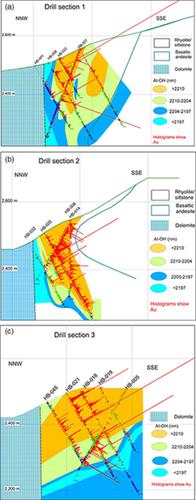当前位置:
X-MOL 学术
›
Resour. Geol.
›
论文详情
Our official English website, www.x-mol.net, welcomes your
feedback! (Note: you will need to create a separate account there.)
Geology, mineralization and short wave infrared alteration mapping of the Khan Altai Au deposit, Mongolia
Resource Geology ( IF 1.1 ) Pub Date : 2021-04-05 , DOI: 10.1111/rge.12260 Khaliunaa Iderbat 1 , Mandalbayar Ganbat 2 , Nyamdorj Densmaa 2 , Bat‐Erdene Khashgerel 1 , Davaa‐Ochir Dashbaatar 2 , Imants Kavalieris 1
Resource Geology ( IF 1.1 ) Pub Date : 2021-04-05 , DOI: 10.1111/rge.12260 Khaliunaa Iderbat 1 , Mandalbayar Ganbat 2 , Nyamdorj Densmaa 2 , Bat‐Erdene Khashgerel 1 , Davaa‐Ochir Dashbaatar 2 , Imants Kavalieris 1
Affiliation

|
Khan Altai Au deposit is located near the N margin of the Neoproterozoic-Cambrian Lake terrain in SW Mongolia, about 5 km from its contact with the Proterozoic-Archean Baydrag craton, and 18 km SE of the Khantaishir ophiolite, which was emplaced in the Late Cambrian. The host rocks are strongly deformed and metamorphosed to lower greenschist facies, and of uncertain age. They comprise a sequence of rhyolitic volcaniclastics and porphyritic flows interbedded with laminated siltstone, basaltic andesite and faulted against dolomite. Low-grade gold mineralization (up to 2 ppm Au) is hosted mainly in rhyolitic volcanics and extends over an area of about 1,100 × 160 m with a vertical extent of about 200 m. It is associated with disseminated pyrite (2–10% by vol) but includes high-grade zones (up to 183 ppm Au over 1 m) related to cm-wide quartz-native Au-pyrite veins. The Au mineralized zone also encompasses VMS mineralization (currently of minor extent), characterized by massive pyrite-sphalerite lenses and quartz-chalcopyrite stringer zones. A larger VMS deposit (Ereen Budagt, about 10 Mt sulfide ore) is found 6 km to the SSE in a similar geological setting. The main alteration assemblage is quartz-white mica-albite, but with minor carbonate, chlorite, epidote-actinolite and pyrophyllite-diaspore-dickite alteration. Gold mineralization is related to zones of strong tectonic foliation and formation of phengitic white mica, with an outward zonation to high Al white mica. Pyrite is typically euhedral, and exhibits concentric growth zones, as well as quartz pressure shadows to enclosing foliation, consistent with syngenetic growth during metamorphism and deformation. Other sulfides include arsenopyrite, sphalerite and possible marcasite. Preliminary LA-ICPMS mapping shows pyrite rims are enriched in Au, As, Co, Cu, Ni, Pb, Ag, Mo and Se, the pyrite core is enriched in Co, Bi, Te, and rhyolitic host rock is enriched in K, Ba, V and Tl. Whole rock geochemistry of basaltic andesite to rhyolite, shows N-MORB characteristics for basaltic andesite, as well as a subduction signature for all rocks, and high MgO (~8%), TiO2 (~1%) and low Ni, Cr content in basalt, compatible with a back arc tectonic setting.
中文翻译:

蒙古汗阿尔泰金矿床地质、成矿及短波红外蚀变作图
Khan Altai Au 矿床位于蒙古西南部新元古代-寒武纪湖地貌的 N 边缘附近,距其与元古代-太古代 Baydrag 克拉通接触约 5 公里,距晚 18 公里的 Khantaishir 蛇绿岩东南部 18 公里。寒武纪。主岩强烈变形变质为下层绿片岩相,年代不确定。它们包括一系列流纹质火山碎屑岩和斑状岩流,夹有层状粉砂岩、玄武质安山岩和断层与白云岩。低品位金矿化(高达 2 ppm Au)主要存在于流纹质火山岩中,面积约 1,100 × 160 m,垂直范围约 200 m。它与弥散的黄铁矿(按体积计 2-10%)有关,但包括与厘米宽的石英原生金黄铁矿脉相关的高品位带(1 m 上高达 183 ppm Au)。Au 矿化带还包括 VMS 矿化(目前规模较小),其特征是块状黄铁矿-闪锌矿透镜体和石英-黄铜矿串状带。一个更大的 VMS 矿床(Ereen Budagt,大约 10 Mt 硫化物矿石)位于 SSE 6 公里处,地质环境相似。主要蚀变组合为石英-白云母-钠长石,但有少量碳酸盐、绿泥石、绿帘石-阳起石和叶蜡石-水铝石-地开石蚀变。金矿化与强烈的构造叶理带和白云母的形成有关,向外分带为高铝白云母。黄铁矿通常是自形的,并表现出同心生长区,以及石英压力阴影到封闭叶理,与变质和变形过程中的同生生长一致。其他硫化物包括毒砂、闪锌矿和可能的白铁矿。LA-ICPMS初步测绘显示黄铁矿边缘富含Au、As、Co、Cu、Ni、Pb、Ag、Mo和Se,黄铁矿核富含Co、Bi、Te,流纹质基质富含K, Ba、V 和 Tl。玄武安山岩到流纹岩的全岩石地球化学,显示玄武安山岩的 N-MORB 特征,以及所有岩石的俯冲特征,以及高 MgO (~8%)、TiO Pb、Ag、Mo、Se,黄铁矿核富含Co、Bi、Te,流纹质母岩富含K、Ba、V、Tl。玄武安山岩到流纹岩的全岩石地球化学,显示玄武安山岩的 N-MORB 特征,以及所有岩石的俯冲特征,以及高 MgO (~8%)、TiO Pb、Ag、Mo、Se,黄铁矿核富含Co、Bi、Te,流纹质母岩富含K、Ba、V、Tl。玄武安山岩到流纹岩的全岩石地球化学,显示玄武安山岩的 N-MORB 特征,以及所有岩石的俯冲特征,以及高 MgO (~8%)、TiO2 (~1%) 和玄武岩中的低镍、铬含量,与弧后构造环境兼容。
更新日期:2021-06-05
中文翻译:

蒙古汗阿尔泰金矿床地质、成矿及短波红外蚀变作图
Khan Altai Au 矿床位于蒙古西南部新元古代-寒武纪湖地貌的 N 边缘附近,距其与元古代-太古代 Baydrag 克拉通接触约 5 公里,距晚 18 公里的 Khantaishir 蛇绿岩东南部 18 公里。寒武纪。主岩强烈变形变质为下层绿片岩相,年代不确定。它们包括一系列流纹质火山碎屑岩和斑状岩流,夹有层状粉砂岩、玄武质安山岩和断层与白云岩。低品位金矿化(高达 2 ppm Au)主要存在于流纹质火山岩中,面积约 1,100 × 160 m,垂直范围约 200 m。它与弥散的黄铁矿(按体积计 2-10%)有关,但包括与厘米宽的石英原生金黄铁矿脉相关的高品位带(1 m 上高达 183 ppm Au)。Au 矿化带还包括 VMS 矿化(目前规模较小),其特征是块状黄铁矿-闪锌矿透镜体和石英-黄铜矿串状带。一个更大的 VMS 矿床(Ereen Budagt,大约 10 Mt 硫化物矿石)位于 SSE 6 公里处,地质环境相似。主要蚀变组合为石英-白云母-钠长石,但有少量碳酸盐、绿泥石、绿帘石-阳起石和叶蜡石-水铝石-地开石蚀变。金矿化与强烈的构造叶理带和白云母的形成有关,向外分带为高铝白云母。黄铁矿通常是自形的,并表现出同心生长区,以及石英压力阴影到封闭叶理,与变质和变形过程中的同生生长一致。其他硫化物包括毒砂、闪锌矿和可能的白铁矿。LA-ICPMS初步测绘显示黄铁矿边缘富含Au、As、Co、Cu、Ni、Pb、Ag、Mo和Se,黄铁矿核富含Co、Bi、Te,流纹质基质富含K, Ba、V 和 Tl。玄武安山岩到流纹岩的全岩石地球化学,显示玄武安山岩的 N-MORB 特征,以及所有岩石的俯冲特征,以及高 MgO (~8%)、TiO Pb、Ag、Mo、Se,黄铁矿核富含Co、Bi、Te,流纹质母岩富含K、Ba、V、Tl。玄武安山岩到流纹岩的全岩石地球化学,显示玄武安山岩的 N-MORB 特征,以及所有岩石的俯冲特征,以及高 MgO (~8%)、TiO Pb、Ag、Mo、Se,黄铁矿核富含Co、Bi、Te,流纹质母岩富含K、Ba、V、Tl。玄武安山岩到流纹岩的全岩石地球化学,显示玄武安山岩的 N-MORB 特征,以及所有岩石的俯冲特征,以及高 MgO (~8%)、TiO2 (~1%) 和玄武岩中的低镍、铬含量,与弧后构造环境兼容。











































 京公网安备 11010802027423号
京公网安备 11010802027423号